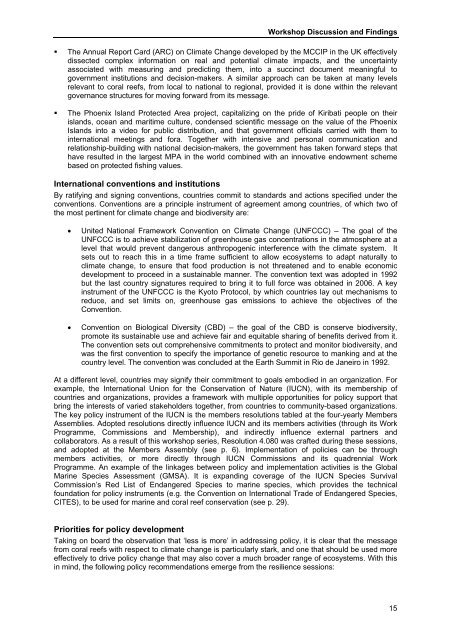Obura2009-IUCN Congress report - Resilience sessions
Obura2009-IUCN Congress report - Resilience sessions.pdf
Obura2009-IUCN Congress report - Resilience sessions.pdf
You also want an ePaper? Increase the reach of your titles
YUMPU automatically turns print PDFs into web optimized ePapers that Google loves.
Workshop Discussion and Findings<br />
• The Annual Report Card (ARC) on Climate Change developed by the MCCIP in the UK effectively<br />
dissected complex information on real and potential climate impacts, and the uncertainty<br />
associated with measuring and predicting them, into a succinct document meaningful to<br />
government institutions and decision-makers. A similar approach can be taken at many levels<br />
relevant to coral reefs, from local to national to regional, provided it is done within the relevant<br />
governance structures for moving forward from its message.<br />
• The Phoenix Island Protected Area project, capitalizing on the pride of Kiribati people on their<br />
islands, ocean and maritime culture, condensed scientific message on the value of the Phoenix<br />
Islands into a video for public distribution, and that government officials carried with them to<br />
international meetings and fora. Together with intensive and personal communication and<br />
relationship-building with national decision-makers, the government has taken forward steps that<br />
have resulted in the largest MPA in the world combined with an innovative endowment scheme<br />
based on protected fishing values.<br />
International conventions and institutions<br />
By ratifying and signing conventions, countries commit to standards and actions specified under the<br />
conventions. Conventions are a principle instrument of agreement among countries, of which two of<br />
the most pertinent for climate change and biodiversity are:<br />
• United National Framework Convention on Climate Change (UNFCCC) – The goal of the<br />
UNFCCC is to achieve stabilization of greenhouse gas concentrations in the atmosphere at a<br />
level that would prevent dangerous anthropogenic interference with the climate system. It<br />
sets out to reach this in a time frame sufficient to allow ecosystems to adapt naturally to<br />
climate change, to ensure that food production is not threatened and to enable economic<br />
development to proceed in a sustainable manner. The convention text was adopted in 1992<br />
but the last country signatures required to bring it to full force was obtained in 2006. A key<br />
instrument of the UNFCCC is the Kyoto Protocol, by which countries lay out mechanisms to<br />
reduce, and set limits on, greenhouse gas emissions to achieve the objectives of the<br />
Convention.<br />
• Convention on Biological Diversity (CBD) – the goal of the CBD is conserve biodiversity,<br />
promote its sustainable use and achieve fair and equitable sharing of benefits derived from it.<br />
The convention sets out comprehensive commitments to protect and monitor biodiversity, and<br />
was the first convention to specify the importance of genetic resource to manking and at the<br />
country level. The convention was concluded at the Earth Summit in Rio de Janeiro in 1992.<br />
At a different level, countries may signify their commitment to goals embodied in an organization. For<br />
example, the International Union for the Conservation of Nature (<strong>IUCN</strong>), with its membership of<br />
countries and organizations, provides a framework with multiple opportunities for policy support that<br />
bring the interests of varied stakeholders together, from countries to community-based organizations.<br />
The key policy instrument of the <strong>IUCN</strong> is the members resolutions tabled at the four-yearly Members<br />
Assemblies. Adopted resolutions directly influence <strong>IUCN</strong> and its members activities (through its Work<br />
Programme, Commissions and Membership), and indirectly influence external partners and<br />
collaborators. As a result of this workshop series, Resolution 4.080 was crafted during these <strong>sessions</strong>,<br />
and adopted at the Members Assembly (see p. 6). Implementation of policies can be through<br />
members activities, or more directly through <strong>IUCN</strong> Commissions and its quadrennial Work<br />
Programme. An example of the linkages between policy and implementation activities is the Global<br />
Marine Species Assessment (GMSA). It is expanding coverage of the <strong>IUCN</strong> Species Survival<br />
Commission’s Red List of Endangered Species to marine species, which provides the technical<br />
foundation for policy instruments (e.g. the Convention on International Trade of Endangered Species,<br />
CITES), to be used for marine and coral reef conservation (see p. 29).<br />
Priorities for policy development<br />
Taking on board the observation that ‘less is more’ in addressing policy, it is clear that the message<br />
from coral reefs with respect to climate change is particularly stark, and one that should be used more<br />
effectively to drive policy change that may also cover a much broader range of ecosystems. With this<br />
in mind, the following policy recommendations emerge from the resilience <strong>sessions</strong>:<br />
15


















